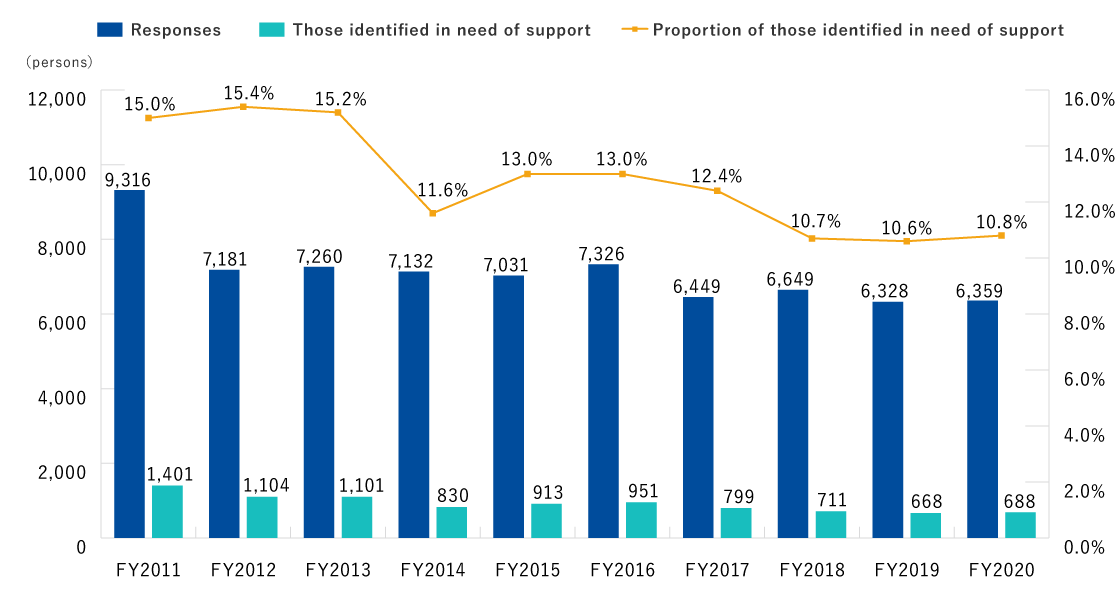Pregnancy and Birth Survey
Outline of the Pregnancy and Birth Survey (Main Survey)
Purpose
This survey was designed and started to understand the physical and mental health status of pregnant and nursing mothers in Fukushima Prefecture after the Great East Japan Earthquake and Fukushima Daiichi Nuclear Power Plant accident, and in order to alleviate their anxiety, as well as to provide them necessary care for a sense of security and enhance obstetric and perinatal care in Fukushima Prefecture.
Survey Period
From FY2011 to FY2020
Eligible persons
- Those who received their Maternal and Child Health Handbook from municipalities in Fukushima Prefecture between August 1 of the previous year and July 31 of the survey year.
- Those who received their Maternal and Child Health Handbook from municipalities outside Fukushima Prefecture during the above period, but who underwent maternal health checks and gave birth in Fukushima Prefecture (so-called “homecoming delivery”)
Method and questionnaire items
Self-administered questionnaire
- Pregnancy outcomes and health status of the child
- Mental health of pregnant and nursing mothers
- Current living conditions (evacuation, family separation)
- Childbirth status and maternal health status during pregnancy
- Confidence in child rearing
- Expectations for the next pregnancy
Follow-ups
Those who responded to the Pregnancy and Birth Survey immediately after the earthquake had a particularly high proportion of depressive tendencies, and the content of their free comments included serious topics. For this reason, follow-up surveys were conducted from FY2015 (for the FY2011 survey respondents) to FY2018 (for the FY2014 survey respondents), corresponding to four years after childbirth, when the number of mothers who lose confidence about rearing their children tends to increase and there are no health checks for their children. The purpose of the follow-up survey was to ascertain the health status of respondents and to continue providing telephone support to those who need it.
Respondents to the FY2011 and FY2012 PBS showed a high tendency toward depression, and there was still a certain number of people with low subjective health, depressive tendencies, and concerns about the effects of radiation. Therefore, we conducted the second follow-up survey (with support) from 2019 to 2022.
Eligible persons
Of those who responded to the Main Survey between FY2011 and FY2014 (excluding those who had miscarriages, abortions, or stillbirths), those who were confirmed to live with their children through inquiries to the municipalities of their residence.
Method and questionnaire items
Self-administered questionnaire (postcard)
- Mothers’ mental health
- Confidence in child rearing
- Anxiety about radiation effects
- Child’s illness
- Concerns about their child
Implementation Status
FY2020 Main Survey
- No. of eligible persons: 11,382
- No. of responses: 6,359
- Response rate: 55.9%
2nd FY2014’s Follow-up Survey
- Eligible persons: 5,248
- No. of responses: 2,266
- Response rate: 43.2%
Provision of support to those in need
The Center has a dedicated support team with midwives, public health nurses, and other qualified staff. We provide consultation and support via telephone and e-mail to those who were identified as needing support, based on the contents of their questionnaire responses. Beyond providing support, we respond to incoming calls and email messages from residents to address their concerns.
FY2020 Main Survey
- No. of responses: 6,359
- No. of those identified in need of support: 688
- Percent of those receiving support: 10.8%
2nd FY2014’s Follow-up Survey (Interim results)
- No. of responses: 2,266
- No. of those identified in need of support: 414
- Percent of those receiving support: 18.3%
Summary
Significance of the survey
- We clarified changes over time in the rates of preterm birth, low birth weight, and congenital anomalies in the prefecture, and found these to be on par with national rates, thus demonstrating the safety of pregnancy and childbirth in the prefecture.
- The proportion of respondents who answered “I tend to feel depressed” and/or “I am not interested in things” was higher in the beginning of the survey than in the FY2013 national survey, but has been on a downward trend since then.
- Of respondents who checked boxes indicating their anxieties about radiation effects, the most common anxiety was about “child’s health.” However, the proportion of those having anxiety about radiation effects has been decreasing over time.
Significance of support
- In the Main Survey, we have provided telephone support to nearly 1,000 people every fiscal year. The major topics of telephone consultations varied from year to year, and the most common topic immediately after the 3.11 disaster was “radiation effects and concerns”, but this proportion decreased over time. Since FY2012, the proportions of contents regarding the mother’s own physical and mental state and child rearing (daily life) have increased the most common.
- In the Follow-up Surveys, “mothers’ physical and mental health” has consistently been the most common topic since the first follow-up survey for FY2011, which was launched in FY2015, and the proportion of consultations regarding “radiation effects and concerns” has decreased over time.









